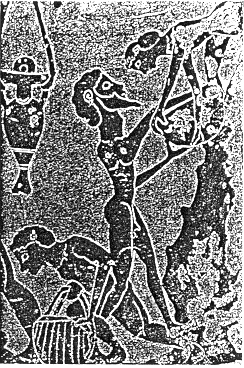|
|
||||
|
LEAD Action News
Vol
2 no 4
Spring 1994.
ISSN 1324-6011 |
||||
|
About Us
|
The Ancient World was Poisoned by Lead by John Emsley Reprinted from New Scientist 1 October 1994 p 14
In this century, lead levels in the air began to climb in the early 1930s, when tetraethyl lead was introduced to boost the performance of petrol. Since then, emissions from cars have polluted not only cities and roadsides, but the whole planet. A team led by Claude Boutron of Domaine University, Grenoble, has now found that earlier civilisations also contaminated the planet with lead. They report levels of the metal four times as high as natural background levels (Science, vol 265, p 1841). Boutran and his colleagues analysed 22 sections of a core 3000 metres long which was drilled at Summit, Greenland, by scientists on the Greenland Ice-Core Project. The researchers selected ice layers corresponding to a period 1360 to 1775 years ago. They also analysed sections from before and after this time. In an ultraclean cold room, the geologists used a lathe made entirely of polyethylene to shave samples from the ice core. The lead it contained was measured using a device known as a graphite furnace atomic absorption spectrometer. The researchers also measured the levels of sodium and aluminium in the ice and also used an artificial ice core, made from ultrapure water, as a control. By comparing shavings from the surface of the core with those from deeper within, the scientists discovered that the bit that was used to drill the ice core contaminated the outer layers slightly but that the deeper layers were pristine. While the level of lead varied over the years, the levels of aluminium and sodium did not. The researchers found that the lead level rose from a natural background, arising from rock dust and volcanoes, of about 0-5 picograms per gram of ice to about 2 pg/g at the time of Christ. By AD 500, it had fallen to the natural level. The lead level began to rise again around AD 1000, reaching 4 pg/g by AD 1500. This increase in the Middle Ages was caused by extensive mining and smelting of silver and lead in Germany. The mining of lead on a large scale began in Greece about 500 BC with the advent of silver mining near Athens. Galena, a grey mineral which contains a small percentage of silver, is mainly lead sulphide. To extract the silver, the Greeks roasted the ore and then cupelled the molten metal. Cupelling involved heating the metal in a pot with a blast of hot air to oxidise the lead, which was then skimmed off. Lead first became an important commercial metal at the time of the Roman Empire, when people used it for cisterns, roofing, pipes and paints. They even used its salts as the artificial sweetener sapa. City dwellers were exposed to high levels of lead in their diet, as has been shown by the analysis of human bones disinterred in Rome. Some have suggested that this explains the empire's eventual decline. The Romans mined lead in many parts of the empire, including Britain, but especially in Spain. More than 80 000 tonnes of lead per year were produced when mining was at its height, and Boutron estimates that the open-air furnaces then in operation would have released about 5 per cent of it into the atmosphere. Some reached the middle troposphere and was deposited in snow in the polar regions. Boutron calculates that over the 800 years of Ancient Greek and Roman civilisation, a total of 400 tonnes of lead reached Greenland. |
|||
|
About
Us |
bell
system lead poisoning |
Contact Us
| Council
LEAD Project | egroups | Library
- Fact Sheets | Home
Page | Media Releases Newsletters | Q & A | Referral lists | Reports | Site Map | Slide Shows - Films | Subscription | Useful Links | Search this Site |
||||
|
Last
Updated 14 November 2012
|
||||

 Who says pollution is a modern problem? French geologists have discovered
that snow falling at the time of the Ancient Greeks and Romans contained an unexpectedly
high concentration of lead. The amount of lead precipitated from the atmosphere between
500 BC and 300 AD totalled 15 per cent of the lead pollution caused this century by leaded
petrol. The team also found higher than expected levels of lead pollution for the Middle
Ages, running frorn around 1000 AD to 1500 AD.
Who says pollution is a modern problem? French geologists have discovered
that snow falling at the time of the Ancient Greeks and Romans contained an unexpectedly
high concentration of lead. The amount of lead precipitated from the atmosphere between
500 BC and 300 AD totalled 15 per cent of the lead pollution caused this century by leaded
petrol. The team also found higher than expected levels of lead pollution for the Middle
Ages, running frorn around 1000 AD to 1500 AD.